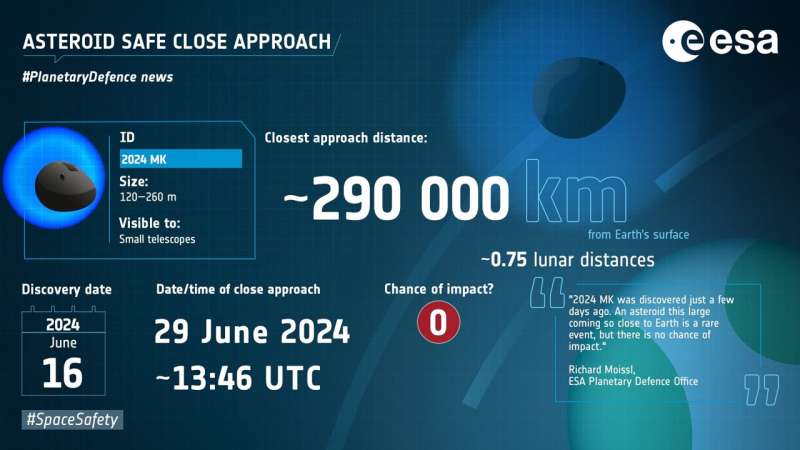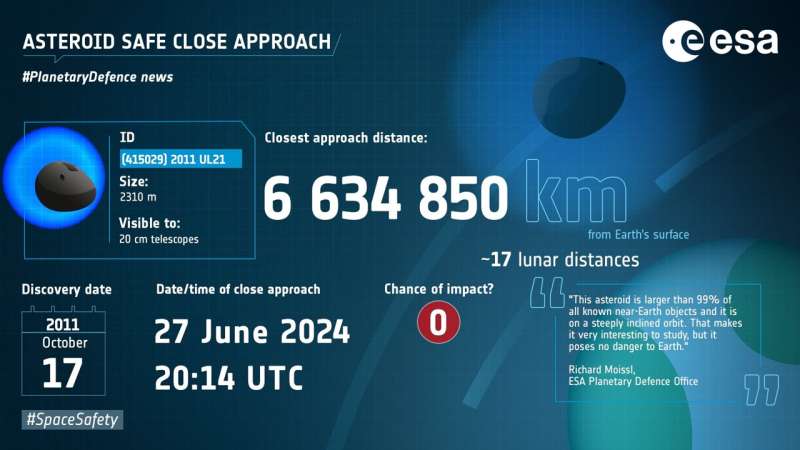
Asteroid 2024 MK will pass by Earth on June 29 at around 13:45 UTC (15:45 CEST). It is between 120 and 260 mi wide and will pass within the Moon’s orbit. Credit: European Space Agency
Two large asteroids will safely pass Earth this week, a rare occurrence timed to commemorate this year’s Asteroid Day.
None of them pose any danger to our planet, but one of them was discovered just a week ago, underscoring the need to continue improving our ability to detect potentially dangerous objects in our cosmic neighborhood.
2024 MK – less than two weeks between discovery and flight
Asteroid 2024 MK is between 120 and 260 m in size and was discovered on June 16, 2024. The asteroid will pass by Earth on June 29 during the peak of this year’s Asteroid Day activities.
2024 MK is large for a near-Earth object (NEO) and will pass within 290,000 km of Earth’s surface – roughly 75% of the distance between Earth and the Moon.
There is no risk of 2024 MK hitting Earth. However, an asteroid of this size would cause significant damage if it did, so its detection just a week before it flew by our planet highlights the continued need to improve our ability to detect and monitor objects potentially dangerous near-Earth (NEO).
Because of its size and proximity, 2024 MK will be observable in dark, clear skies on June 29 using a small telescope or binoculars, good for amateur astronomers in some parts of the world. Plan your observations using ESA’s NEO toolkit.
(415029) 2011 UL21 – larger than 99% of near-Earth asteroids
Asteroid (415029) 2011 UL21 is the largest of the week’s visitors. With a width of 2310 m, this asteroid is larger than 99% of all known near-Earth objects (NEOs). However, it will not be as close to Earth. At its closest point on June 27, it will still be more than 17 times farther than the Moon.

Asteroid (415029) 2011 UL21 will pass by Earth on June 27, at 20:14 UTC (22:14 CEST). At 2,310 m wide, it is larger than 99% of all known near-Earth objects (NEOs), but poses no threat to Earth and will pass more than 17 times farther than the moon. Credit: European Space Agency
This asteroid’s orbit around the sun is inclined, which is unusual for such a large object. Most large objects in the solar system, including planets and asteroids, orbit the sun at or near the equatorial plane.
This could be the result of gravitational interactions with a large planet like Jupiter. Jupiter can deflect previously safe asteroids inward toward Earth, so understanding this process is important.
(415029) 2011 UL21 is in an ’11:34 resonance’ with Earth. It completes 11 revolutions around the sun in about the same amount of time that the Earth completes 34 revolutions (ie 34 years).
The result is a nice repeating pattern when visualizing the location of the asteroid relative to Earth over a period of 34 years, keeping the Earth fixed in place.
Asteroid Day 2024
The impact craters that mar the Earth’s surface are evidence of how asteroids have greatly influenced the history and development of our planet.
The UN-sanctioned Asteroid Day commemorates the largest observed asteroid impact in history – the 1908 airburst over Tunguska in largely arid Siberia, which felled an estimated 80 million trees.
This represented a lucky escape for Europe: it occurred only a short rotation of the Earth away from the influence of the most populated regions of the continent.
ESA is in a unique position, with the cooperation and support of its Member States, to coordinate the data, information and expertise needed to understand and respond to asteroid hazards in Europe and to participate in efforts to wide range of planetary protection of humanity.
Over the past two decades, ESA has been conducting detection and analysis of potentially hazardous NEOs. There are an estimated 5 million NEOs out there larger than 20m – the threshold above which an impact can cause damage to the ground.
ESA boosts asteroid activities
ESA’s Planetary Defense Office is conducting a number of projects dedicated to improving our ability to detect, track and mitigate potentially hazardous asteroids.
Launching later this year, ESA’s Hera mission is part of the world’s first asteroid deflection test. Hera will conduct a detailed post-impact study of the asteroid Dimorphos after impact by NASA’s DART mission in September 2022 and help turn the experiment into a well-understood and repeatable planetary defense technique. Members of the Hera team will take part in Asteroid Day celebrations later this week.
Back on Earth, ESA is developing a network of insect-inspired Flyeye telescopes that will use their uniquely wide field of view to automatically scan the entire sky each night for potentially dangerous new asteroids.
Our future NEOMIR satellite will be placed between the Earth and the Sun. It will use infrared light to spot asteroids approaching our planet from regions of the sky that cannot be seen from Earth because they are obscured by the brightness of our star.
Meanwhile, the Office of Planetary Defense continues to keep an eye on the skies today. ESA’s Fire Camera in Cáceres, Spain, captured a stunning meteor during the night of 18-19 May 2024, which is thought to have been a small fragment of a comet that flew over Spain and Portugal traveling at approximately 162,000 km /h before burning. over the Atlantic Ocean.
Just a few weeks later, on June 6, 2024, the Catalina Sky Survey in Arizona, USA detected a small asteroid 2–4 m in size that triggered an alert from ESA’s Immediate Impact Monitoring System (Meerkat).
That alert was not for an impact, but for a very close call. A few hours later, the object flew by the Catalina Sky Survey telescope which detected it at a distance of only 1,750 km, making it the second closest pass of a known non-impact asteroid ever.
Provided by the European Space Agency
citation: Two large asteroids safely pass Earth just 42 hours apart (2024, June 24) Retrieved June 24, 2024 from https://phys.org/news/2024-06-large-asteroids-safely-earth- hours.html
This document is subject to copyright. Except for any fair agreement for study or private research purposes, no part may be reproduced without written permission. The content is provided for informational purposes only.
#large #asteroids #safely #pass #Earth #hours
Image Source : phys.org